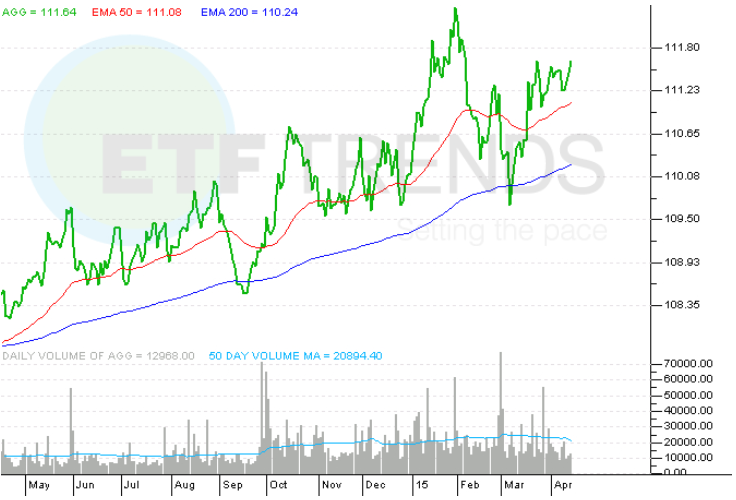Aggregate Bond ETFs to Establish a Fixed-Income Portfolio’s Core
Investors who want to build a fixed-income portfolio can lay a solid core foundation with a high-quality and broad mix of debt assets through an aggregate bond index-based exchange traded funds.
For example, the iShares Core U.S. Aggregate Bond ETF (AGG) is one of the largest, cheapest and most liquid investment that tracks the widely observed Barclays US Aggregate Bond Index, writes Thomas Boccellari, a passive strategies analyst for Morningstar.
AGG’s underlying index includes a broad mix of fixed-rate, investment-grade government, corporate and securitized bonds that are weighted by float-adjusted market capitalization. Consequently, the portfolio tilts towards issuers with the largest debt, so the government and securitized bonds make up the largest chunk of the aggregate bond ETF’s holdings.
Specifically, AGG has 38.0% Treasuries, 27.6% MBS pass-through securities, 14.1% industrials, 7.6% financials, 4.3% agency bonds and 1.8% utilities.
“This gives the fund a high-quality portfolio,” Boccellari said. “The average credit rating of its holdings is A, which is higher than its average intermediate-term bond peer’s (BBB). While that may help the fund hold up better when equities or lower-quality bonds sell off, it can also result in lower expected returns amid credit rallies or risk-seeking environments.”
The iShares Aggregate Bond ETF comes with a 5.06 year duration and a 1.79% 30-day SEC yield. Additionally, the fund has a cheap 0.08% expense ratio.
The aggregate bond index fund has outperformed the average actively managed intermediate-bond fund over the past decade, with a better risk-adjusted return. It goes to show that it is difficult for active managers to beat the benchmark index net of fees without being exposed to greater credit or interest-rate risks.
The Vanguard Total Bond Market ETF (BND) provides another option to gain exposure to the Barclays U.S. Aggregate Bond Index. BND is the largest ETF to track the benchmark, but the fund provider excludes securities held by the Fed. Nevertheless, Boccellari argues that the exclusion has not provided any noticeable impact on the performance. BND has a 5.6 year duration, a 1.88% 30-day SEC yield and a 0.08% expense ratio.
Additionally, the Schwab U.S. Aggregate Bond ETF (SCHZ) , which also tracks the same index, is the cheapest option available, with a 0.06% expense ratio. However, SCHZ is smaller than its competitors at $1.6 billion in assets under management, compared to BND’s $26.8 billion and AGG’s $24.2 billion. SCHZ has a 1.92% 30-day SEC yield and a 5.16 year duration. [Big Money Loves Fixed Income ETFs]
iShares Core U.S. Aggregate Bond ETF
For more information on the fixed-income market, visit our bond ETFs category.
Max Chen contributed to this article.
The opinions and forecasts expressed herein are solely those of Tom Lydon, and may not actually come to pass. Information on this site should not be used or construed as an offer to sell, a solicitation of an offer to buy, or a recommendation for any product.

